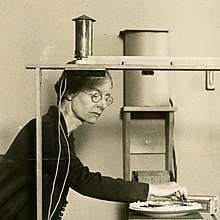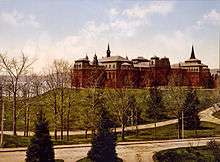Louise Sherwood McDowell
Louise Sherwood McDowell (29 September 1876 - 6 July 1966) was an American physicist and educator. She spent most of her career as a professor of physics at Wellesley College and is best known for being one of the first female scientists to work at the United States Bureau of Standards, now the National Institute of Standards and Technology.[1]
Louise Sherwood McDowell | |
|---|---|
 adjusting an experiment at Wellesley.jpg | |
| Born | September 29, 1876 Wayne, New York, U.S. |
| Died | July 6, 1966 (aged 89) Wellesley, Massachusetts, U.S. |
| Nationality | American |
| Education | Wellesley College, B.A. 1898 Cornell University, M.A. 1907 Cornell University, Ph.D. 1909 |
| Scientific career | |
| Fields | Dielectrics Luminescence |
| Institutions | Wellesley College |
Early life and education
Louise McDowell was born in Wayne, New York, to Francis Marion and Eva (Sherwood) McDowell. McDowell received her B.A. in 1898 from Wellesley College. Following graduation she worked as a high school teacher of English, science, and mathematics until 1905.[2]

She was then admitted to Cornell University. The chair of the physics department, Edward Nichols was supportive of women in physics. McDowell worked on short-wave radiation under Ernest Merritt. She earned an M.A. in 1907 followed by a Ph.D. in 1909.[3] McDowell attended Cornell at approximately the same time as Frances Wick. The two became friends and later collaborated on research.[4][5]
Career
After receiving her Ph.D., McDowell returned to work at Wellesley College as an instructor of the physics department in 1909. After Sarah Frances Whiting's retirement, McDowell served as chairman of the physics department until 1945.
In 1918 during World War I, McDowell took a leave of absence from Wellesley when she was hired by the National Institute of Standards and Technology to conduct research on radar. She was the first female physicist and the first female Ph.D. to work at the institute.[6][1][7]
McDowell was a fellow of the American Physical Society and American Association for the Advancement of Science, a member of the Optical Society of America, and vice president for the American Association of Physics Teachers.[3]
References
- Cochrane, Rexmond (1966). Measures for Progress: A History of the National Bureau of Standards. Washington, D.C.: U.S. Department of Commerce. p. 170.
- Ogilvie, Marilyn; Harvey, Joy (2003-12-16). The Biographical Dictionary of Women in Science: Pioneering Lives From Ancient Times to the Mid-20th Century. Routledge. p. 866. ISBN 9781135963439.
- "Obiturary". Physics Today. 8 (97): 97. 1966. doi:10.1063/1.3048429.
- Wick, Frances G.; McDowell, Louise S. (1918-06-01). "A Preliminary Study of the Luminescence of the Uranyl Salts under Cathode Ray Excitation". Physical Review. 11 (6): 421–429. Bibcode:1918PhRv...11..421W. doi:10.1103/PhysRev.11.421.
- Ogilvie, Marilyn; Harvey, Joy (2003-12-16). The Biographical Dictionary of Women in Science: Pioneering Lives From Ancient Times to the Mid-20th Century. Routledge. p. 866. ISBN 9781135963439.
- Rossiter, Margaret W. (1982). Women scientists in America : struggles and strategies to 1940. Baltimore: Johns Hopkins University Press. pp. 118. ISBN 0801824435. OCLC 8052928.
- "Women's History Month: NIST's First Female Ph.D. (Edison was a fan!)". National Institute of Standards and Technology. March 1, 2017. Archived from the original on 6 June 2017.